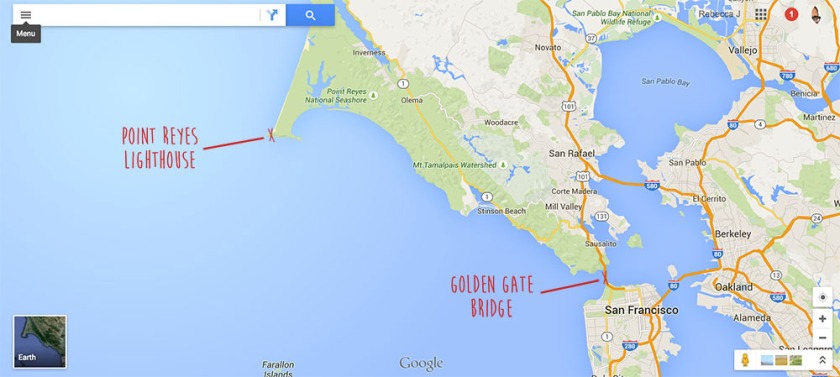
Recently, a yearning for a Sunday adventure took me to one of the most remote parts of the Bay Area: the Point Reyes Lighthouse. I followed in the footsteps of Sir Francis Drake who landed at Point Reyes in 1579, albeit in a 20-year-old Honda Accord instead of the ‘Golden Hind‘.


About Point Reyes
The Point Reyes Lighthouse sits on the western-most point on a peninsula that juts out from the mainland in Marin County. This natural feature, as well as the extreme weather conditions (according to the National Parks Service, Point Reyes is windiest site on the California coast and the second foggiest place on the North American continent), has long made it treacherous for ships sailing in and out of the Bay. So the Point Reyes headlands was the perfect place to build a lighthouse.





I drove for what seemed like an eternity, winding around foggy, desolate landscape, the way I’d always imaged the wild moors of Yorkshire to look like from ‘Wuthering Heights’. I couldn’t see a lighthouse, even when I reached the car park. I found it curious that the lighthouse was not visible at all from the road — any other lighthouse I’d visited was visible for miles, standing tall on a headland. I parked the car, walked a few hundred metres, and suddenly the little huts with red roofing appeared below.





The lighthouse was constructed in 1870, perched on rocks well below the top of the headland. The reason it was built down the incline was due to the thick blanket of fog usually enveloping the coast (particularly in the summer months), and so by building the lighthouse below the natural fogline, it enabled ships a greater chance to see the beacon and thus have a better chance of navigating the waters.



The internal mechanisms of the lighthouse were constructed in France in 1867, and shipped over to the US the long way round – by way of Argentina. The lighthouse station also housed a fog horn that guided ships in addition to the lighthouse. It took a while to construct the lighthouse and associated buildings, and the first official night of operation for the station was December 1, 1870.



Point Reyes is so remote, even in the age of horseless carriages, that moving out here to be a lighthouse keeper certainly would have been an experience. Just a glance at the logs for 1888 reveal incredibly difficult work and long hours. Even though the lamp would only be lit between sun-up and sun-down, the keeper (and his three assistants) would be working around the clock doing all manner of other jobs. They would clean and service the lamps of the lighthouse, make and fix machinery parts, investigate shipwrecks (notably called “barks”), endure bad weather, and plenty of delivering coal, painting and cleaning the lamps of the lighthouse.
The keepers dealt with insubordination and frequent personnel changes. There is evidence in the logs kept by the keeper of assistants refusing to work until sunset, others failing to be diligent about the upkeep of the fog horn, and many going AWOL when they were supposed to be on duty.


Another keeper [from Point Reyes Station], as he was transferred to East Brother Light, made final notation in his log “Returning to USA”.
A log entry, January 30, 1889, read: “The second assistant went crazy and was handed over to the Constable in Olema”. [Source]
It was such a hard, undesirable station to be posted to, yet one keeper loved it so much he ended up staying for 24 years.

In 1975, an automated service replaced the role of the lighthouse keeper. But the horn still echoes out into the blue expanse of the Pacific Ocean during the day and into the fog as it rolled into shore in the later afternoon.
Hemmed in by fog, Point Reyes felt like the most remote location I’ve ever experienced.



What a beautiful post! #takemeback 😀 I really like the photos you’re taking.
x, Juliet
Thanks so much for the kind words, Juliet!